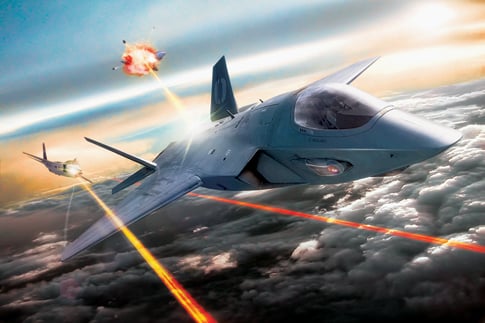Laser Fighters: 100 kW Weapons By 2022
Posted on
PENTAGON: Star Wars fans, calm down. The US Air Force wants to fire a 100-plus-kilowatt laser from a small plane. And not just any airplane, Air Force Research Laboratory officials. The last laser on an airplane — the megawatt Airborne Laser, which filled a converted 747 and cancelled in 2011 — the 2022 demonstration will be fired from a fighter.
But this isn’t a real-world X-Wing. It probably won’t even be an F-35A because that’s a stealth aircraft that carries its weapons inside to give it a smaller radar cross section. Instead, the 2022 weapon will be built into an external weapons pod.
It’s a crawl-walk-run approach, said Morley Stone, the Air Force Research Laboratory’s chief technology officer. Modern electrically powered, solid-state laser technology is “orders of magnitude” simpler and more compact than the vats of toxic chemicals that powered the cancelled Airborne Laser, Stone told reporters at Thursday’s “DoD Lab Day” in the Pentagon courtyard. But technological advances still don’t make putting lasers on airplanes simple. So, he said, “before we start getting into really what we consider a lot of risk with internal carriage integration, we’re going to look at external integration via a pod.”
Even an external pod on a fighter, however, is a much tighter and more challenging fit for a laser weapon than, say, the massive weapons bay on an AC-130 gunship. Special Operations Command wants a laser cannon on future AC-130s, but “what we’re doing is taking the most challenging case, and that’s on a fighter,” said AFRL director Maj. Gen. Thomas Masiello. “As technology advances, it can be spun right off into a larger platform like the AC-130.”
By way of comparison, the only forward-deployed laser weapon in the US military today is a 30-kW prototype installed on the broad decks of the USS Ponce, a converted amphibious assault ship now in the Persian Gulf. Lasers fired from a ship face some unique problems that an airplane doesn’t. Sea air is full of moisture, which can weaken and distort the laser beam. Higher altitude air is clearer, but airborne lasers still require sophisticated corrective optics to stay focused on their target. While the atmospherics are arguably easier for an airborne laser than a shipborne one, ships are a lot bigger than a fighter.
“Air applications actually can be the most challenging,” said AFRL laser guru David Hardy. (His formal title is “Director, Directed Energy Directorate” — yes, really, he says with an apologetic smile). “On a ship, I’m probably going to have more SWAP [Size Weight And Power] than I’m going to have on an aircraft,” Hardy said. What’s more, he went on, “aircraft tend to shake more than a ship does: A ship rolls but it doesn’t vibrate as much.” Vibration is hard on any complex machinery, but it’s especially problematic for a laser, which has to hold its beam steady enough to burn through a single spot on the target.
“A laser is basically a heating device,” Hardy said. “It heats up something. It melts holes in it. That’s what we do.” But it takes a lot of technology to get that hot spot on target, especially when fired from a flying platform. While the military has abandoned the bulky chemical lasers used on the Airborne Laser program, the experience of building ABL taught valuable lessons that still apply to the more compact electrically powered lasers of today, Hardy told me. “Making ABL work was not just fitting the laser in: It was building the beam control system, it was building the pointing system, it was building the targeting,” Hardy said. “We learned a lot from that.”
Another crucial evolutionary step is the General Atomics HELLADS laser, which will soon shift from a DARPA experiment to a DARPA-Air Force Research Lab joint venture. “That was a major investment on the part of DARPA,” Hardy said. “It’s the first time anybody’s shown you can make a 150-kW-class electric laser.”(The exact power output of HELLADS isn’t published, and many details are classified). The whole point of HELLADS was to build a high-power laser weapon small enough that it could fit on an aircraft, although it’s never actually been installed in one. So while HELLADS is technically a ground-based weapon, it generates a lot of power in a compact package, making it “the existence proof that we can really make these electric lasers work in the greater-than-100-kw regime, in a reasonable SWAP [Size Weight And Power].”
“We believe [that] in the next decade we’ll have systems that routinely deliver over 100 kw,” Hardy told me. “Exactly how many hundreds of kilowatts we don’t know.”

A laser experiment at the Air Force Research Laboratory
Future Firepower
What can 100-plus kilowatts kill? Hardy was cagey about specific targets, but a study from the Center for Strategic and Budgetary Assessments suggests that it could destroy enemy cruise missiles, drones, and even manned aircraft at significant ranges.
“A 150-200 kW laser could be capable against surface-to-air and air-to-air missiles,” said CSBA’s Mark Gunzinger, the report’s author. And against manned aircraft? “Quite probably,” he said, “especially at altitude where the air is thinner.”
Maj. Gen. Masiello explicitly brought up lasers as potential replacements for air-to-air missiles. “The ultimate almost unlimited magazine is provided with directed energy[:]One laser shot we estimate would take about a liter of fuel,” he said, “but that’s a ways off.”
“Missile defense is our biggest interest,” Hardy told me, just as it is for the Navy and Army laser programs. “But we’re also interested in the offensive capability they provide, because…as long as you have jet fuel that can be converted into electricity to feed the laser, I can keep firing the weapon.”
A typical modern fighter like the F-16 can carry at most six air-to-air missiles. Shoot six times, hit or miss, and it’s back to base to re-arm. By contrast, said Gunzinger, a laser-armed aircraft could just head back to the tanker. “Instead of landing to reload, air refueling would ‘reload’ [laser]-equipped aircraft in flight,” he said. They could keep fighting until the pilot couldn’t take it any more — or, if unmanned, for longer than any human could endure.
“There are several developmental lasers, including HELLADS, that are making great progress” towards making a weapon compact enough for an aircraft, Gunzinger told me. “Aircraft-based laser weapons could be a near-term reality.”
One of the Air Force’s leading futurists, retired Lt. Gen. Dave Deptula, was even more enthusiastic about the possibilities for airborne lasers — and, someday, spaceborne ones. In the near term, he told me, the place to start is probably short-ranged defensive systems: Instead of trying to overcome the power, focus, and atmospheric distortion problems required to strike targets far away, he said, you let the enemy come to you. But laser’s long term potential lies at long range, and aerospace platforms are the way to get there.
Lasers are just intense beams of light, after all. They get attenuated by the atmosphere and can’t fire indirectly at targets beyond the horizon the way a missile or artillery shell can. The higher the laser’s altitude, the farther it can shoot and the less atmosphere is getting in the way. This is where Air Force laser weapons have a potential that ship- or ground-based lasers can’t match.
“You can just imagine the kinds of advantages there are when you free yourself from the atmosphere,” Deptula told me. Beyond firing from high-altitude aircraft, he said, “there are some enormous opportunities here to use lasers in space or from space,” for example to shoot down enemy aircraft or ballistic missiles from above. Current international treaties prevent that, he acknowledged, and “we don’t want to weaponize space, but guess what: it’s gonna happen — so we need to be prepared to operate in space and from space.”
From space, from the air, or from the surface, lasers have genuinely revolutionary potential. “The term ‘game changing ‘ is thrown around pretty loosely,” Deptula said, but it fits here. “Since Chuck Yeager first broke the sound barrier, in the late forties, we’ve been engaging at the speed of sound,” he told me. Now the US, Russia, and China are all developing hypersonic weapons that can travel at Mach 5 or more. But with lasers, he said, “now you’re talking about engaging at the speed of light.”
Subscribe to our newsletter
Promotions, new products and sales. Directly to your inbox.

